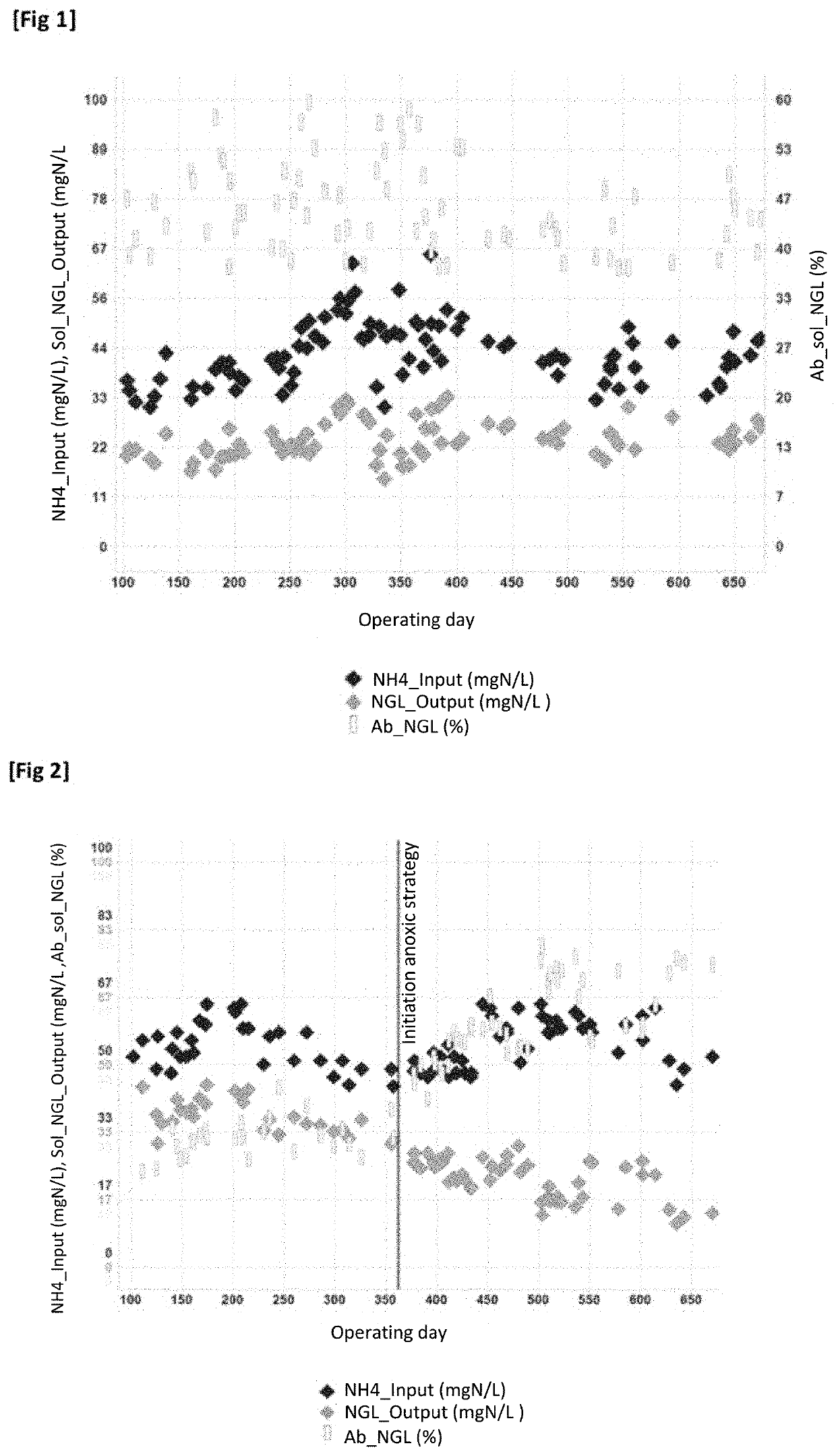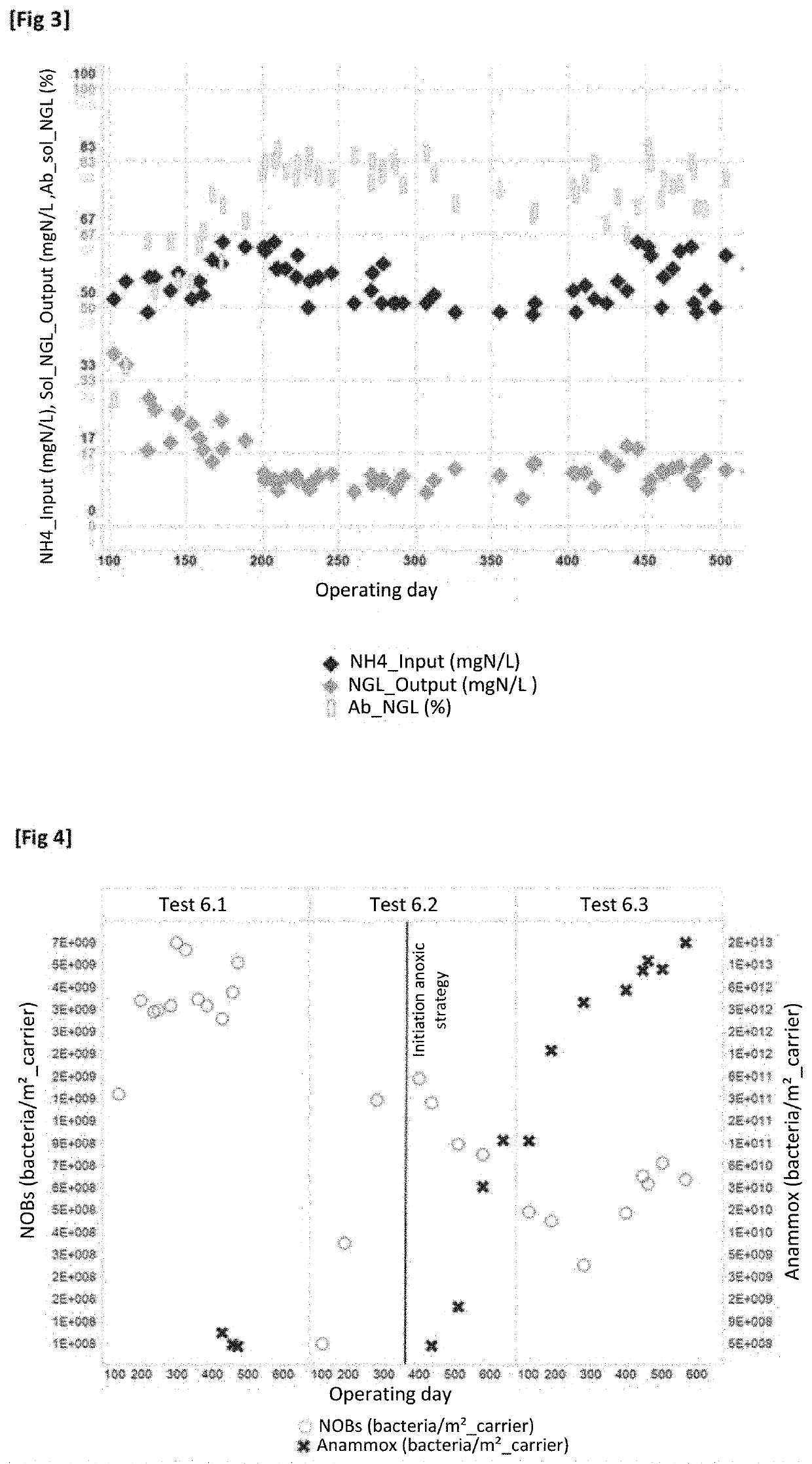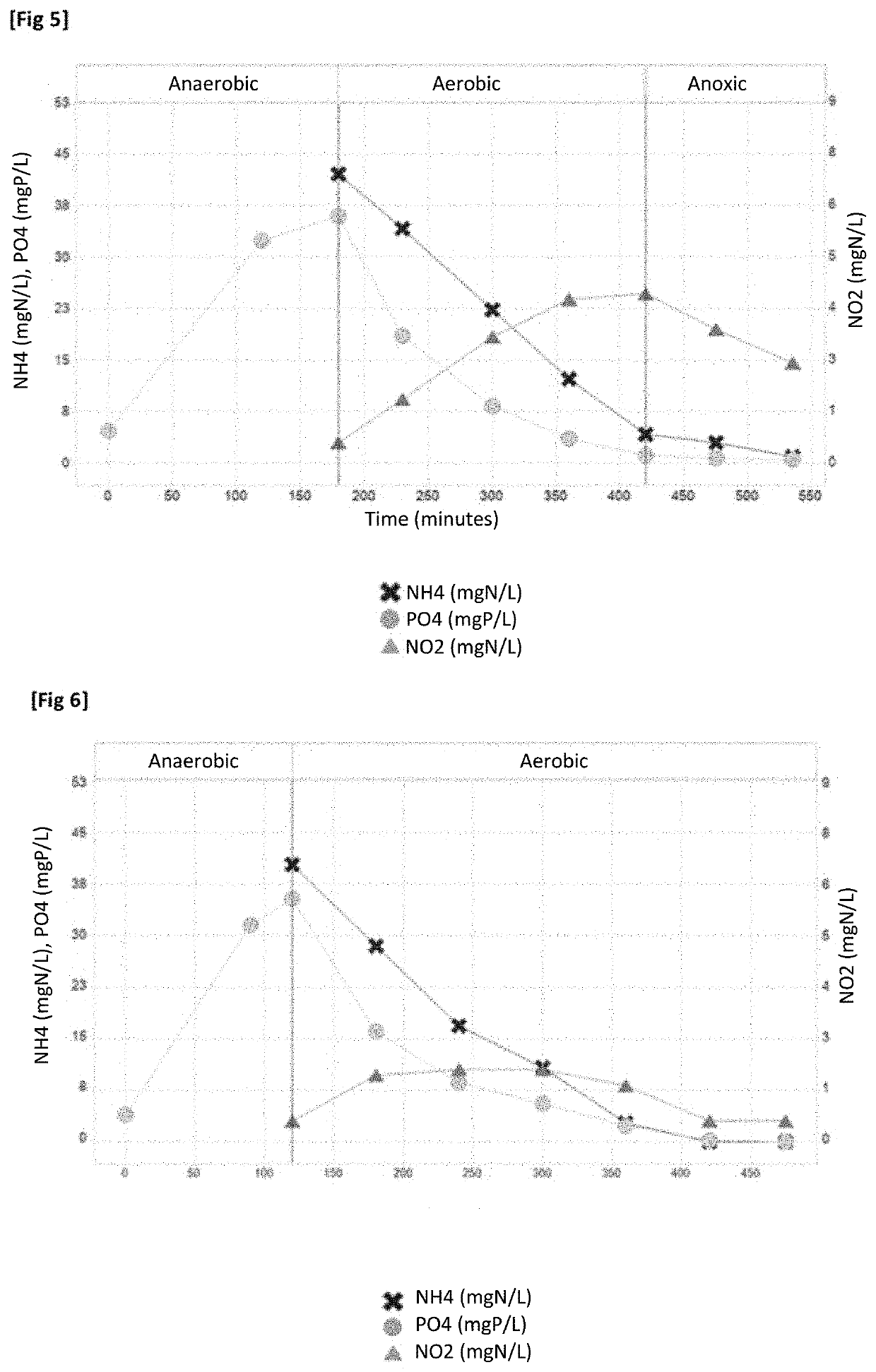Water Treatment Method for Simultaneous Abatement of Carbon, Nitrogen and Phosphorus, Implemented in a Sequencing Batch Moving Bed Biofilm Reactor
Pending Publication Date: 2022-01-20
VEOLIA WATER SOLUTIONS & TECH SUPPORT
View PDF1 Cites 0 Cited by
- Summary
- Abstract
- Description
- Claims
- Application Information
AI Technical Summary
Benefits of technology
[0039]The filling step of the SBMBBR can be carried out more or less quickly. In particular, the filling time can be comprised between 30 minutes and 5 hours, preferably between 90 and 180 minutes. At the end of the filling step, the SBMBBR can be more or less filled. Advantageously, the SBMBBR has a volume exchange ratio (VER) comprised between 90% and 100%. The volume exchange ratio is defined as the ratio between the volume of water discharged at the end of the cycle and the total volume of water in the SBMBBR after the supplying phase. The initial phase of anaerobic treatment lasts from 30 minutes to 5 hours. The anaerobic init
Problems solved by technology
However, biological water treatment methods in a conventional or compartmentalised free biomass SBR reactor have several disadvantages.
A first disadvantage is that due to the low settling speed of the suspended matters (mainly constituted of the purifying free biomass), these methods require the implementation of large volume reactors.
A second disadvantage of these free biomass SBR methods is that they have limited treatment performance, in particular limited performance for nitrification.
Indeed, the activated sludge concentration in the SBR reactor is often limited, in practice strictly less than 5 g/L, in order not to alter the clarification step.
A third disadvantage of these conventional SBR methods is that it is necessary to maintain a high sludge age in the SBR reactor, in practice a sludge age of strictly more than 15 days at 12° C., in order to achieve a sufficient level of nitrification.
This implies a significant increase in the size of the water treatment facilities.
The structure used for this separation step can be particularly compact due to the low SM (suspended matters) concentrations.
Furthermore, the results of concen
Method used
the structure of the environmentally friendly knitted fabric provided by the present invention; figure 2 Flow chart of the yarn wrapping machine for environmentally friendly knitted fabrics and storage devices; image 3 Is the parameter map of the yarn covering machine
View moreImage
Smart Image Click on the blue labels to locate them in the text.
Smart ImageViewing Examples
Examples
Experimental program
Comparison scheme
Effect test
 Login to View More
Login to View More PUM
 Login to View More
Login to View More Abstract
Water treatment method for simultaneous abatement of carbon, nitrogen and phosphorus, implemented in a sequencing batch moving bed biofilm reactor (SBMBBR) comprising carriers suitable for the development of a biofilm. The method comprises sequences of successive treatments, each treatment sequence comprising:
an initial phase of anaerobic treatment,
said initial phase of anaerobic treatment being followed by at least one aerobic/anoxic cycle consisting of: an aerobic treatment phase so as to obtain an ammonium ion concentration that does not pass below a threshold concentration of ammonium ions; and
a phase in which the biofilm is placed, at least locally, under anoxic conditions, this phase being concomitant with or posterior to said aerobic treatment phase; the threshold concentration of ammonium ions being calculated to allow the development of Anammox microorganisms during the phase in which the biofilm is placed, at least locally, under anoxic conditions.
Description
FIELD OF THE INVENTION[0001]The invention relates to the field of water treatment, in particular wastewater for purification.[0002]More precisely, the invention relates to a biological method for simultaneous treatment of carbon, nitrogen and phosphorus in water.[0003]Prior art and its disadvantages[0004]A method for the treatment of wastewater in a conventional free biomass sequencing batch reactor (especially with activated sludge) is known from the prior art. The term “sequencing batch reactor” is also known in the state of the art by the acronym SBR. This method is now widely used throughout the world and is particularly popular because it can be implemented with a single biological basin without the need for a downstream clarifier structure, unlike a conventional method with activated sludge that, due to the continuous water supply, requires the provision of a clarifier structure downstream of the biological basin and the recirculation of the sludge to the biological basin. Thu...
Claims
the structure of the environmentally friendly knitted fabric provided by the present invention; figure 2 Flow chart of the yarn wrapping machine for environmentally friendly knitted fabrics and storage devices; image 3 Is the parameter map of the yarn covering machine
Login to View More Application Information
Patent Timeline
 Login to View More
Login to View More IPC IPC(8): C02F3/30C02F3/08
CPCC02F3/301C02F3/085C02F2101/16C02F3/308C02F3/307C02F2209/14C02F2209/44Y02W10/10C02F2101/105
Inventor FOURCANS, AUDEZOZOR, PHILIPPEGERMAIN, TRISTANHUMBERT, HUGUESLEMAIRE, ROMAIN
Owner VEOLIA WATER SOLUTIONS & TECH SUPPORT
Features
- R&D
- Intellectual Property
- Life Sciences
- Materials
- Tech Scout
Why Patsnap Eureka
- Unparalleled Data Quality
- Higher Quality Content
- 60% Fewer Hallucinations
Social media
Patsnap Eureka Blog
Learn More Browse by: Latest US Patents, China's latest patents, Technical Efficacy Thesaurus, Application Domain, Technology Topic, Popular Technical Reports.
© 2025 PatSnap. All rights reserved.Legal|Privacy policy|Modern Slavery Act Transparency Statement|Sitemap|About US| Contact US: help@patsnap.com



